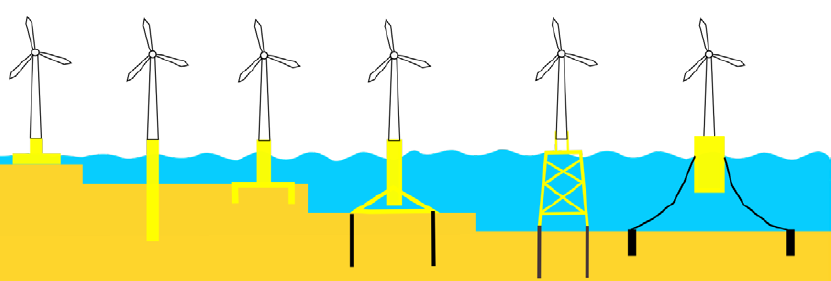3.1.1 The selection of foundation concept will aim to assess one or more different
foundation types to a site. This will generally consider:
- ability of the foundation to meet the requirements (e.g. capacity,
stiffness, long term performance);
- seabed hazards, existing or future, that may impact the ability of the
foundation to fulfil the requirements;
- in-service inspection or maintenance requirements;
- whether the foundation can be successfully installed;
- commercial considerations including cost, schedule, availability etc, both
during design and construction and inspection requirements; and
- decommissioning requirements.
3.1.2 The assessment of a foundation concept should include a series of screening checks to
determine whether a foundation may be suitable for the site. Common screening checks
include:
- presence of and sufficient depth of soil and/or rock and suitability of
seabed types for the foundation;
- presence of seabed features or hazards;
- nearby structures and potential for interaction;
- local or comparable experience with the foundation type including ability to
install;
- seismic hazard;
- likelihood and extent of scour and requirements for structure to function;
- water depth; and
- site investigation data requirements.
3.1.3 Once the screening check has been performed it may be appropriate to progress to
initial sizing of the foundation. This initial sizing check will generally combine
local or similar experience of the foundation with some simple design methodology to
assess the size of foundation required to satisfy all the key requirements (e.g.
capacity and stiffness). Furthermore, it should establish that the installation of
the foundation will be feasible.
3.1.4 Foundation concept selection and associated screening checks are only intended to
give an initial comparison of different foundation solutions and the suitability of
the foundation type(s) to the site. It is expected that the foundation will be
further investigated in future phases of design, if necessary with additional site
investigation data, before the foundation is actually accepted for construction.
3.1.5 A foundation may either be in the monopod form (i.e. only one foundation per
structure) or in a multipod form (i.e. multiple foundations per structure). The
choice of monopod or multipod foundations will depend on the structural
configuration and other conditions such as water depth or seabed conditions will
also have a significant impact on the type of loading that a foundation may see. For
example, a monopile tends to have large lateral loads and more limited axial loads;
whereas the piles on a jacket structure will have much larger axial components of
load. Some examples of structural configuration and foundation layout are shown in
Figure 3.3.1 Examples of foundation concepts.

Figure 3.3.1 Examples of foundation concepts